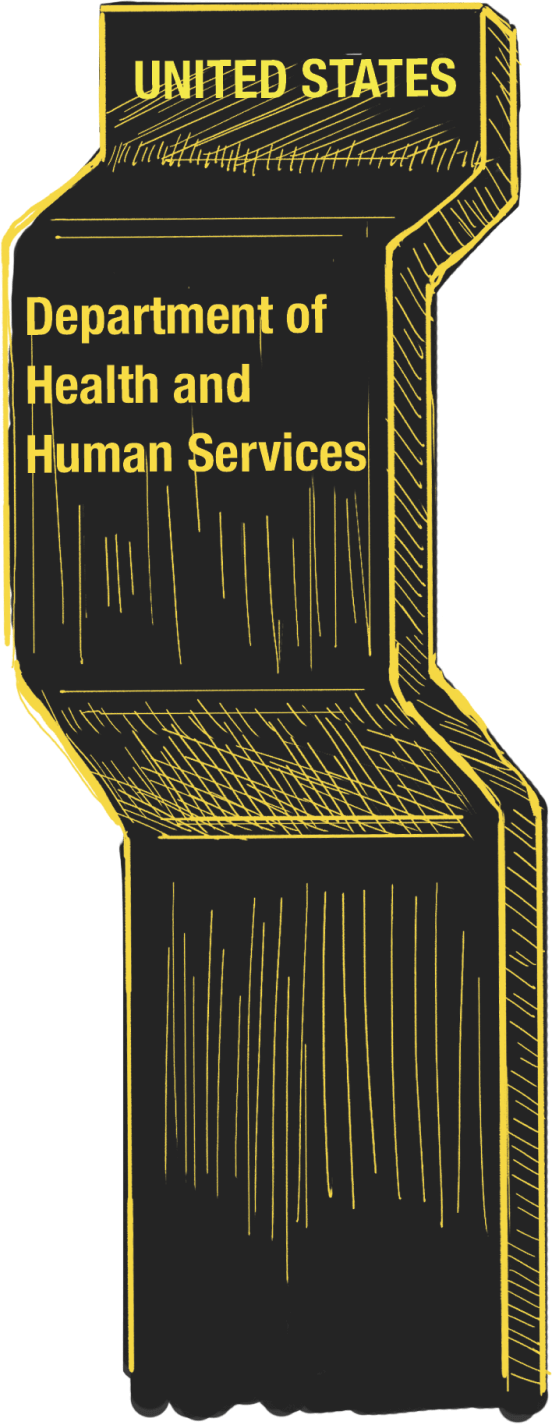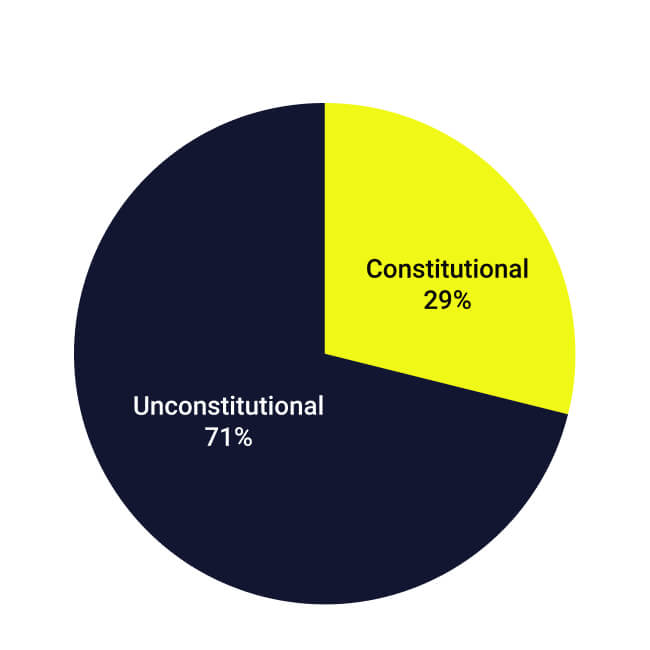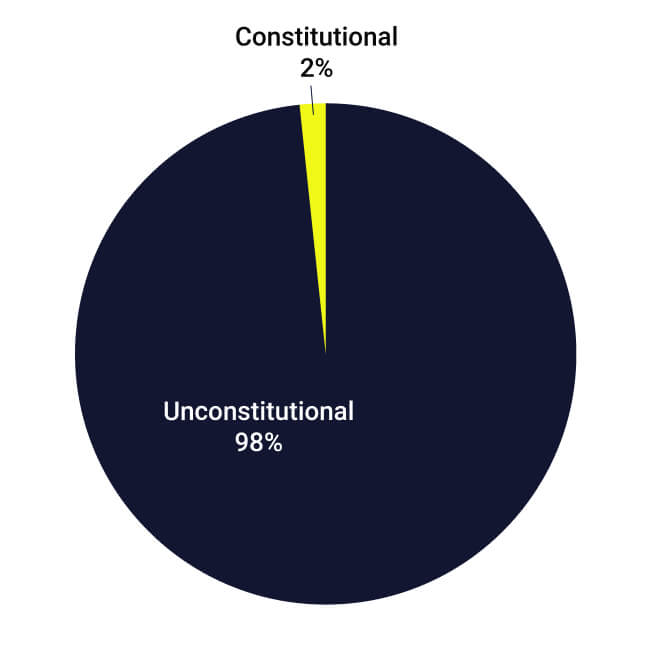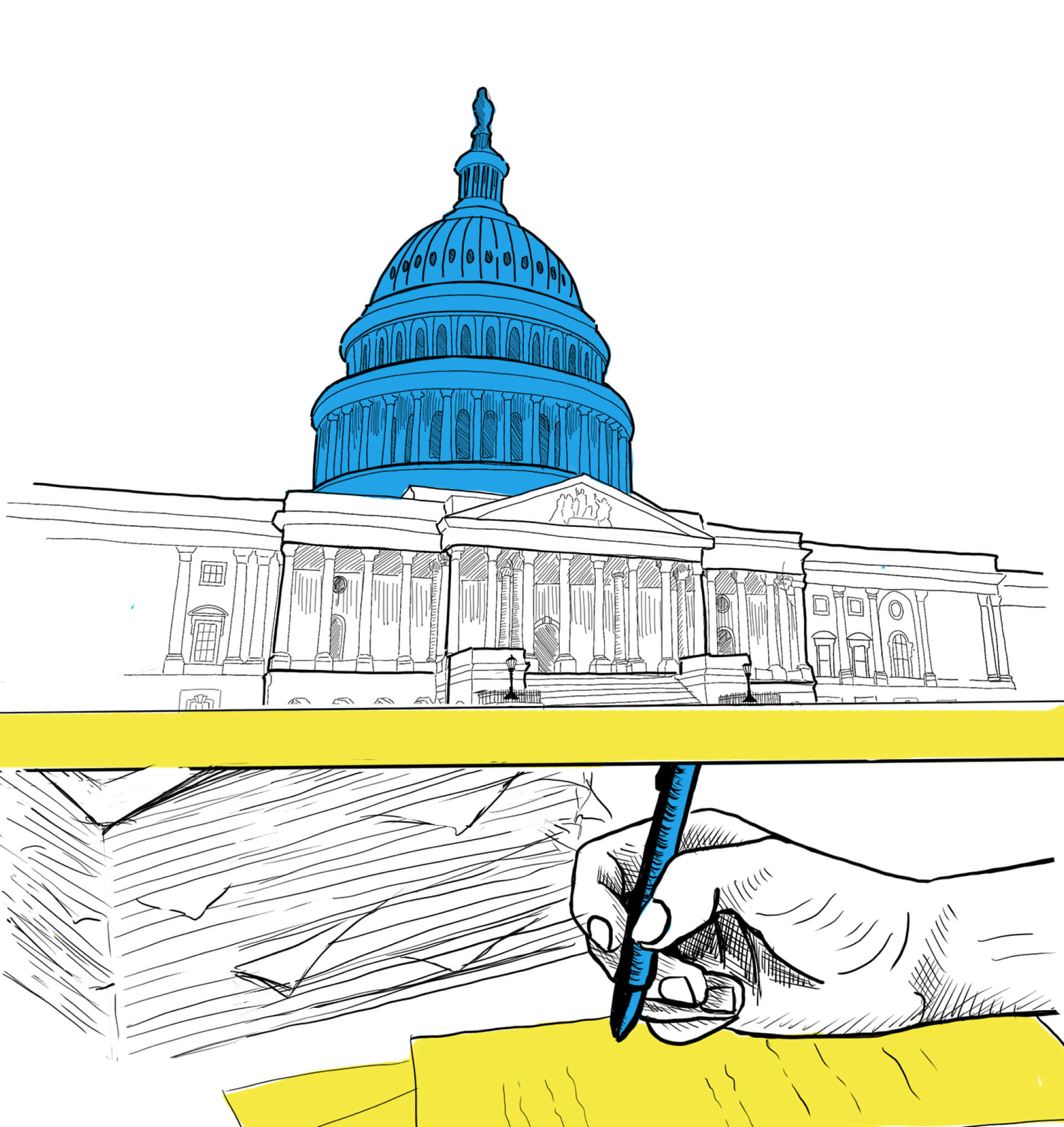Summary
But Who Rules The Rulemakers?
A Study of Illegally Issued Regulations at HHS
by Angela C. Erickson and Thomas Berry
April 29, 2019

Table Of Contents
Executive Summary
An endless expansion of federal agency rules threatens American prosperity, which once was the envy of the world. A thicket of red tape undermines economic growth, job creation, individual liberty, and, in some ways, the rule of law itself.
Most regulations seek to better protect people or the environment, but only a tiny fraction of the rules issued have reliable cost estimates, and those costs often exceed the projected benefits. A 2016 study by the Mercatus Center at George Mason University estimated that burdensome regulations cost Americans $4 trillion in economic growth from 1980 through 2012, resulting in a loss of nearly $13,000 per American. The public bears these costs directly and indirectly through higher prices for goods and services, reduced consumer choices, stagnant wages, lost jobs, and limitations on their freedoms. Businesses don’t “absorb” these losses—people do.
Researchers and government officials are increasingly concerned about the growth of the regulatory state and its drag on American prosperity. Besides exploding costs, binding rules issued by countless agency bureaus and departments dwarf the laws passed by Congress. The rule of law is severely strained when hundreds of offices are issuing thousands of rules that no one can possibly read.
To fix these deep-seated problems, policymakers and the public need to understand what’s driving the increase in regulation. One possible culprit has never been studied before: a large expansion of rulemakers who are not democratically accountable. These unaccountable rulemakers are not constitutionally authorized to issue final rules that have the force of law. But, as this study shows, that hasn’t stopped them.
The Appointments Clause: Making Our Rulers Accountable to the People
The U.S. Constitution requires executive branch officials who exercise significant authority and discretion to be formally appointed in a manner the Appointments Clause specifies in Article II, Section 2. All principal officers must be nominated by the President and confirmed by the Senate before they are appointed. Inferior officers must undergo the same process unless Congress by law authorizes their appointment by the President or a department head. The Framers specified these appointment rules to ensure that all high government officials who exercise significant power over us would be accountable to the people in a meaningful way. The Supreme Court established 33 years ago that rulemaking was one of those significant powers that only democratically accountable officers appointed in this manner could exercise. Rightly so.
Permanent career staff in regulatory agencies have important jobs, but they are not democratically accountable to the people in this manner. They shouldn’t be issuing regulatory law that governs us. Their rules simply aren’t valid.
Study Findings: Unconstitutional Rulemaking Procedures Are Rife at HHS, Especially at the FDA
Pacific Legal Foundation (PLF) analyzed the rulemaking practices of one executive department over several administrations. In a first-of-its-kind study, the researchers examined every regulation issued by the Department of Health and Human Services (HHS) from 2001 through 2017 (2,952 rules). The study focused on who issued each final rule, the rulemaker’s authority, and the rule’s significance.
The study found that a majority of HHS regulations were illegally issued by low-level officials or career employees who had no authority to do so. The Food and Drug Administration (FDA) was the most frequent and clear-cut violator. The FDA’s illegal rules were so numerous that they skewed the results for the rest of HHS.
Key Findings
- Nearly three-fourths (71%) of HHS rules are unconstitutional based on who finalized and issued them.
- The majority of unconstitutional rules at HHS (89%) were issued by the FDA. Among FDA final rules, 98% were issued by career employees who have no constitutional authority to do so.
- In contrast, only 25% of Centers for Medicaid and Medicare Services rules were issued by someone other than a Senate-confirmed officer of the United States.
- Among substantive final rules considered to have a significant regulatory impact by the Office of Management and Budget, 80 from the FDA were unconstitutional—93% of all substantive and significant HHS rules. Twenty-five of those rules had an economic impact of over $100 million each.
Examples of Illegal Rules Uncovered
Ample evidence shows that HHS’s unconstitutional rulemaking has real and serious effects on Americans who live and work under a regulatory regime that is increasingly unrestrained and unaccountable.
Vaping store retailer Steve Green of California cannot share his story of quitting a 30-year smoking habit and recovering from early signs of emphysema without first obtaining government permission, thanks to an FDA rule that affects him and other entrepreneurs.
Figure 1: Percentage of Constitutional and Unconstitutional Final Rules, 2001-2017
Entire HHS Department

food and drug administration

Under FDA rules, dairy farmers such as Randy Sowers of Frederick County, MD, cannot call their skim milk “skim milk” without first adding artificial vitamins.
Even rules with beneficial impacts are at risk if they were illegally issued. Tens of millions of patients who rely on low-cost generic drugs may find their treatment options limited in the future due to slowed approvals of new generics, if courts strike down a helpful FDA rule issued by an FDA employee.
What Can Courts, Congress, and the White House Do?
Regardless of the precise cost of illegal regulations, the existing unconstitutional rules should be struck down by the courts when individually challenged. Rules can then be reissued using constitutional means. The agencies, litigants, and courts can also devise interim regulatory solutions on a rule-by-rule basis.
To restore democratic accountability to the regulatory process in the future, the following reforms should be implemented:
- Congress needs to ensure that rulemaking under statutes it enacts is exercised solely by democratically accountable officers—principal officers nominated by the President and confirmed by the U.S. Senate. It can do so by using confirmation hearings, appropriations bills, and regulatory reform legislation. Congress also needs to expressly prohibit delegations of rulemaking authority from Senate-confirmed officials to career bureaucrats.
- The President can act on his own. With a stroke of his pen, he can and should order his senior appointees to take personal responsibility for regulations issued during his administration.
The current administration made a serious commitment to reduce the regulatory burden, and numerous members of Congress from both parties share this goal. For these reform-minded leaders, ending the unconstitutional practice of delegating authority for issuing final rules should be a top priority.

Introduction
American democracy is built on the separation of powers. No branch of government has absolute power, and each serves as a check on the others. For example, although Supreme Court Justices may invalidate the laws passed by Congress and signed by the President, they can take office only after securing a presidential nomination and Senate confirmation. Only Justices who have gone through this vetting process by the other branches are eligible to issue opinions binding on all Americans.
But suppose that a Supreme Court Justice authorized his law clerks to issue opinions in their own names? What if this went on for 17 years, and no one noticed? The Constitution would not have been ratified if the Framers proposed that employees of the federal judiciary—neither appointed by the President nor confirmed by the Senate—could issue opinions that are legally binding on the public. Such a practice would render the carefully designed system of interbranch checks and balances pointless.
By the same token, the Constitution would not have been ratified if career employees in the executive branch—employees neither appointed by the President nor confirmed by the Senate—could issue final and irreversible regulations that would be legally binding on the public. Yet unlike our law clerk hypothetical, this violation of checks and balances is actually happening: Career employees in some agencies are purporting to issue binding regulations under their own name and authority.
This method of rulemaking is unconstitutional. It is unconstitutional for career employees—instead of democratically accountable officers of the United States—to establish the rules that govern us. The Supreme Court has already held that the power to set national policy through regulations must be exercised solely by officers. Subsequent cases and the original meaning of the Appointments Clause lead strongly to the conclusion that only Senate-confirmed principal officers may issue rules. There is no doubt that career employees may not do so.
This study is the first to examine and present the facts regarding rulemaking by career agency employees. Those facts inform both the legality of their rulemaking and many policy issues surrounding the practice. When these facts are known, Americans can insist that the courts, the President, and Congress prohibit this type of lawmaking by unelected regulators. We hope this study will also spark a broader debate about holding regulatory agencies accountable to the constitutional rules for rulemaking.

What’s At Stake
The growing thicket of red tape created by countless federal regulations stifles American economic growth, wages, and job creation. It raises prices, limits consumer choice, and restricts individual liberty. The toll on economic growth alone is significant. From 1980 through 2012, regulations cost Americans $4 trillion in economic growth—$13,000 per person.1Source: Bentley Coffey, Patrick A. McLaughlin, and Pietro Peretto, “The Cumulative Cost of Regulations,” Mercatus Working Paper (Arlington, VA: Mercatus Center at George Mason University, April 2016), https://www.mercatus.org/publication/cumulative-cost-regulations.
The goals of most regulations are worthy—to better protect individuals and the environment—yet only a tiny fraction of regulations are issued with reliable cost estimates.2Source: Richard Williams, “Comparison of Final Rules with Monetized Benefits and Costs” (Arlington, VA: Mercatus Center at George Mason University, April 23, 2012), http://mercatus.org/publication/comparison-final-rules-monetized-benefits-and-costs. And even then, many regulations have projected costs that exceed the agencies’ estimates of public benefits.3Source: Cass R. Sunstein and Robert W. Hahn, “A New Executive Order for Improving Federal Regulation? Deeper and Wider Cost–Benefit Analysis,” Working Paper No. 150 (Charlottesville, VA: John M. Olin Program in Law and Economics, 2002), https://dash.harvard.edu/handle/1/12795538; Robert W. Hahn, “Regulatory Reform: Assessing the Government’s Numbers,” Working Paper No. 99-6 (Washington, DC: AEI-Brookings Joint Center for Regulatory Studies, 1999), https://ssrn.com/abstract=269630; Robert W. Hahn and Robert E. Litan, “An Analysis of the Third Government Report on the Benefits and Costs of Federal Regulations,” Regulatory Analysis 00-1 (Washington, DC: AEI-Brookings Joint Center, 2000), https://ssrn.com/abstract=243534. Despite recent Supreme Court rulings that encourage or require cost-benefit analysis, 4Source: In 2015, the Supreme Court struck down one Environmental Protection Agency rule after rejecting the EPA’s position that it couldn’t consider costs in its decision to set hazardous air pollutant standards. Michigan v. EPA, 135 S. Ct. 2699, 2708–10 (2015). The EPA maintained it was required to impose many billions in costs for minimal direct benefits. Writing for the Court, Justice Scalia declared that “the phrase ‘appropriate and necessary’ [in the relevant EPA statute] requires at least some attention to cost. One would not say that it is even rational, never mind ‘appropriate,’ to impose billions of dollars in economic costs in return for a few dollars in health or environmental benefits.” Id. at 2707; see also Entergy Corp. v. Riverkeeper, 556 U.S. 208 (2009). Sadly, many federal agencies continue to interpret their regulatory authority in a similarly irrational manner. many regulatory agencies still interpret ambiguous statutes they administer as prohibiting the consideration of costs in their regulatory decisions. Ignoring the costs of regulation allows agency regulators greater discretion to impose massive costs on the public with minor benefits.
The cumulative regulatory costs all Americans suffer are troubling, but the impact of many regulations falls especially hard on particular individuals. For regulations that are unwarranted or illegal, such personal hardships are unjust. This study uncovers hundreds of HHS rules issued in an illegal manner. Many of these rules are also onerous and problematic for other reasons, as the following examples highlight.
After her husband passed away from lung cancer, Kimberly Manor started an innovative business to help longtime smokers quit. At Moose Jooce, a vape store in Lake, Michigan, Kimberly sells vaporizers—small electronic devices that deliver nicotine to users in a mist of inhaled water vapor without the additional chemicals and tar found in cigarette smoke. Kimberly’s business prospered, and she has helped hundreds of people in her small town to quit smoking. 5Source: See Complaint at 3, Moose Jooce v. FDA, No. 1:18-cv-0203 (D.D.C. Jan. 30, 2018).
Unfortunately, the Food and Drug Administration (FDA) threw a wrench in Kimberly’s business model. In 2016, the FDA created a rule deeming vaping products—vaporizers and the liquid used in them—to be subject to the same restrictions placed on cigarettes under the Tobacco Control Act of 2009, even though vaping products contain no tobacco.6Source: Deeming Tobacco Products to Be Subject to the Federal Food, Drug, and Cosmetic Act, as Amended by the Family Smoking Prevention and Tobacco Control Act; Restrictions on the Sale and Distribution of Tobacco Products and Required Warning Statements for Tobacco Products, 81 Fed. Reg. 28,974 (May 10, 2016).
Vaping allows people to obtain nicotine and mimic the experience of smoking without the major causes of cancer—combustion gasses, smoke, and tar. Nicotine is extracted from a plant in the tobacco family or from synthetic tobacco. Because vaping can be customized for the user, former smokers can gradually reduce their nicotine intake by using liquids with declining nicotine levels and eventually no nicotine at all. For example, vaping helped Steve Green, the owner of Mountain Vapors in Sonora, California, quit smoking after 30 years and recover from early signs of emphysema.7Source: See Complaint, supra note 5, at 3.
The Deeming Rule, as the FDA’s regulation of vaping devices is called, imposes years of regulatory hurdles and hundreds of thousands of dollars in costs per product, which is stifling innovation and harming small shop owners across the country. The rule’s mandates take effect in stages. In 2021, it will require “premarket” approval to keep existing vapor products on the market, which means each liquid with a different flavor or different level of nicotine, including liquids with no nicotine, will have to be approved individually through a lengthy process at a cost of up to $466,000 (by the FDA’s own estimation).8Source: Center for Tobacco Products, “Commonly Asked Questions: About the Center for Tobacco Products,” U.S. Food and Drug Administration, questions 1 and 2, accessed February 4, 2019, https://www.fda.gov/tobaccoproducts/aboutctp/ucm378205.htm. And any product introduced after the Deeming Rule went into effect in 2016 must go through this process immediately, which has effectively halted innovation.
For Kimberly and Steve, this rule also means they are no longer able to repair products for their customers. This premarket approval process will be prohibitively expensive for small business owners across the country, while big companies can better afford the approval process for their few vaping products.9Source: “These regulations have already damaged my business and my customers,” said Steve. “For example, some popular liquids are no longer available because small manufacturers and retailers can’t afford to navigate the regulatory process. I’ve also had to stop helping customers build or repair their vape pens. I stopped because it could classify me as a manufacturer and bury me under regulations.”
In addition to stifling Kimberly’s and Steve’s ability to sell vaping products, the Deeming Rule also limits their free speech. No matter how accurate their product descriptions and ingredient lists are, they must secure FDA approval for them. In addition, they are severely restricted in their ability to advertise or educate consumers about how they can quit smoking using vaping products without FDA approval for their speech.
Steve notes that the “restrictions stop me from sharing my personal story.” As he explains, “For years, I smoked 2-1/2 packs of cigarettes a day, and it nearly gave me emphysema. Vaping freed me from my addiction, and the doctor says I’ve recovered.”10Source: “Arbitrary Federal Vaping Regulations Threaten Businesses, Consumers—and Constitutional Rights” (Pacific Legal Foundation, January 30, 2018), https://pacificlegal.org/press-release/arbitrary-federal-vaping-regulations-threaten-businesses-consumers-and-constitutional-rights/.
Beyond making it expensive and onerous for entrepreneurs, vapers, and cigarette smokers who want to quit, the Deeming Rule has a more fundamental problem: The rule was issued by a career employee. While the employee has been with the FDA for 30 years and was promoted to a senior career position, she was never nominated by any President or confirmed by the Senate for any democratically accountable office. For that basic reason, the rule was illegal the moment it hit the books. Tenure does not confer constitutional authority.
The Constitution requires regulations to be issued by appointed officials subject to the democratic process, not by unelected public servants. The career employee who issued the Deeming Rule, Leslie Kux, probably didn’t know that the rulemaking power she was asked to exercise was unconstitutional. But good intentions can’t transform an illegal rule into a legal one.
Kimberly and Steve have teamed up with Pacific Legal Foundation to sue the FDA over this unconstitutional practice of using career bureaucrats to issue rules binding on Americans. In early 2018, PLF attorneys challenged the Deeming Rule with three lawsuits, representing eight small vaping businesses and the nonprofit Tobacco Harm Reduction 4 Life.11Source: Based on the government’s procedural motions and rulings on them, two of the cases were transferred to the district court in the District of Columbia, where the third suit was filed. Consideration of the substance of the challenges is in its early stages in that court at the time of this publication. The FDA demonstrated its fear that the Deeming Rule is in legal jeopardy by purporting to cure the constitutional problem with a “ratification” letter by outgoing FDA Commissioner Gottlieb dated April 3, 2019—almost three years after Kux issued the rule. Gottlieb’s letter denies that there is any constitutional defect that needs to be cured. But, the highly unusual intervention during litigation speaks louder than his denial that there is no problem to cure. Plaintiffs will contest the validity of this attempted ratification of one rule. As to the many other unconstitutional rules, if ratification by a new official can ever be lawful, it must, at the very least, be based a knowing review of each rulemaking record. An attempted mass ratification of over two thousand HHS rules would be unprecedented and even more questionable than ratification of any one rule. In these and other lawsuits, PLF’s clients seek to enforce the constitutional separation of powers and the democratic accountability that the Founding generation established in the Constitution.
Vaping store retailers are only one example of those harmed by illegal regulations uncovered by our research—regulations that restrict individuals and small businesses across the country. In another example, dairy farmer Randy Sowers is required to call the milk produced by his cows “imitation skim milk” for the sole reason that he skims the fat off it and does not add synthetic vitamins.12Source: “Family-Run Farm Sues FDA for Right to Say Skim Milk Is Skim Milk” (Institute for Justice, April 5, 2018), http://ij.org/press-release/family-run-farm-sues-fda-right-say-skim-milk-skim-milk/. He is not allowed to call it what it is, skim milk, because of a rule signed by an unelected public servant.13Source: Lowfat and Skim Milk Products, Lowfat and Nonfat Yogurt Products, Lowfat Cottage Cheese: Revocation of Standards of Identity; Food Labeling, Nutrient Content Claims for Fat, Fatty Acids, and Cholesterol Content of Food, 61 Fed. Reg. 58,991-01 (Nov. 20, 1996).
Even the rules that do effectively promote the health and safety of Americans are at risk of being invalidated if they were issued in an illegal manner. For example, Congress passed a law authorizing an expedited approval process for generic drugs,14Source: Food and Drug Administration Safety and Innovation Act, 126 Stat. 993 (2012). and the FDA subsequently issued a regulation governing what that new approval process would be.15Source: Abbreviated New Drug Applications and 505(b)(2), 81 Fed. Reg. 69,580-01 (Oct. 6, 2016). The new process essentially eliminated the wait for generic drug approvals—what had been a list of 2,800 applications was slashed to around 100 applications. 16Source: Raymond J. March, “FDA Approves Record Number of Generic Drugs in 2018,” The Beacon, January 9, 2019, http://blog.independent.org/2019/01/09/fda-approves-record-number-of-generic-drugs-in-2018/. The lower prices resulting from new approvals during an 18-month period were estimated to save Americans $26 billion.17Source: “FDA in Brief: FDA Highlights Record-Breaking Number of Generic Drug Approvals in October,” U.S. Food and Drug Administration, November 9, 2018, https://www.fda.gov/NewsEvents/Newsroom/FDAInBrief/ucm625627.htm. But the FDA rule that established the new process was issued by a career employee. The rule is therefore unconstitutional, despite its benefits.
This report is the first to systematically review whether final rules published in the Federal Register are constitutional based on who signed and issued them. The next section provides the context for the factual findings that follow, explaining both how such subdelegation of rulemaking authority violates the Constitution and why it is a serious problem for both democracy and liberty.
The report then presents the research on how common it is for HHS agencies to rely on unconstitutional rulemaking by low-level officials and employees. We analyzed all the final rules issued by HHS during the past 17 years, focusing on the individuals who actually made each final decision to enact a rule binding on the public. Unfortunately, the practice of having career staff sign final rules such as the Deeming Rule is especially common for FDA rules. Our results show that the FDA is an outlier among the various units of HHS, though it is not the only unit to impose rules without democratic controls.18Source: Through 2018 and early 2019, Leslie Kux continued to issue final FDA rules. See 83 Fed. Reg. 54,006, 54,007, 54,665, 54,869, 54,873, 54,875. As of March 2019, career employees in the FDA continue to issue final rules. See 84 Fed. Reg. 8,967, 9,226, 9,228. We hope outgoing FDA Commissioner Gottlieb’s attempted ratification of the Deeming Rule on April 3, 2019, (see note 11) signals serious reexamination of the practice of career employees issuing final rules. But the ratification was more likely made solely as an attempt to thwart litigation over that one rule. Moreover, a law or executive order is still needed to prevent thousands of more rules from being illegally issued at FDA and other agencies.
By examining, in detail, the frequency and variability with which each HHS agency has complied (or not complied) with the Appointments Clause in its rulemaking activities, this study also suggests the need to evaluate the problem across the federal government. The report’s final section sets forth possible solutions to end unconstitutional rulemaking procedures.
Endnotes
1 Bentley Coffey, Patrick A. McLaughlin, and Pietro Peretto, “The Cumulative Cost of Regulations,” Mercatus Working Paper (Arlington, VA: Mercatus Center at George Mason University, April 2016), https://www.mercatus.org/publication/cumulative-cost-regulations.
2 Richard Williams, “Comparison of Final Rules with Monetized Benefits and Costs” (Arlington, VA: Mercatus Center at George Mason University, April 23, 2012),
http://mercatus.org/publication/comparison-final-rules-monetized-benefits-and-costs.
3 Cass R. Sunstein and Robert W. Hahn, “A New Executive Order for Improving Federal Regulation? Deeper and Wider Cost–Benefit Analysis,” Working Paper No. 150 (Charlottesville, VA: John M. Olin Program in Law and Economics, 2002), https://dash.harvard.edu/handle/1/12795538; Robert W. Hahn, “Regulatory Reform: Assessing the Government’s Numbers,” Working Paper No. 99-6 (Washington, DC: AEI-Brookings Joint Center for Regulatory Studies, 1999), https://ssrn.com/abstract=269630; Robert W. Hahn and Robert E. Litan, “An Analysis of the Third Government Report on the Benefits and Costs of Federal Regulations,” Regulatory Analysis 00-1 (Washington, DC: AEI-Brookings Joint Center, 2000), https://ssrn.com/abstract=243534.
4 In 2015, the Supreme Court struck down one Environmental Protection Agency rule after rejecting the EPA’s position that it couldn’t consider costs in its decision to set hazardous air pollutant standards. Michigan v. EPA, 135 S. Ct. 2699, 2708–10 (2015). The EPA maintained it was required to impose many billions in costs for minimal direct benefits. Writing for the Court, Justice Scalia declared that “the phrase ‘appropriate and necessary’ [in the relevant EPA statute] requires at least some attention to cost. One would not say that it is even rational, never mind ‘appropriate,’ to impose billions of dollars in economic costs in return for a few dollars in health or environmental benefits.” Id. at 2707; see also Entergy Corp. v. Riverkeeper, 556 U.S. 208 (2009). Sadly, many federal agencies continue to interpret their regulatory authority in a similarly irrational manner.
5 See Complaint at 3, Moose Jooce v. FDA, No. 1:18-cv-0203 (D.D.C. Jan. 30, 2018).
6 Deeming Tobacco Products to Be Subject to the Federal Food, Drug, and Cosmetic Act, as Amended by the Family Smoking Prevention and Tobacco Control Act; Restrictions on the Sale and Distribution of Tobacco Products and Required Warning Statements for Tobacco Products, 81 Fed. Reg. 28,974 (May 10, 2016).
7 See Complaint, supra note 5, at 3.
8 Center for Tobacco Products, “Commonly Asked Questions: About the Center for Tobacco Products,” U.S. Food and Drug Administration, questions 1 and 2, accessed February 4, 2019, https://www.fda.gov/tobaccoproducts/aboutctp/ucm378205.htm.
9 “These regulations have already damaged my business and my customers,” said Steve. “For example, some popular liquids are no longer available because small manufacturers and retailers can’t afford to navigate the regulatory process. I’ve also had to stop helping customers build or repair their vape pens. I stopped because it could classify me as a manufacturer and bury me under regulations.”
10 “Arbitrary Federal Vaping Regulations Threaten Businesses, Consumers—and Constitutional Rights” (Pacific Legal Foundation, January 30, 2018), https://pacificlegal.org/press-release/arbitrary-federal-vaping-regulations-threaten-businesses-consumers-and-constitutional-rights/.
11 Based on the government’s procedural motions and rulings on them, two of the cases were transferred to the district court in the District of Columbia, where the third suit was filed. Consideration of the substance of the challenges is in its early stages in that court at the time of this publication. The FDA demonstrated its fear that the Deeming Rule is in legal jeopardy by purporting to cure the constitutional problem with a “ratification” letter by outgoing FDA Commissioner Gottlieb dated April 3, 2019—almost three years after Kux issued the rule. Gottlieb’s letter denies that there is any constitutional defect that needs to be cured. But, the highly unusual intervention during litigation speaks louder than his denial that there is no problem to cure. Plaintiffs will contest the validity of this attempted ratification of one rule. As to the many other unconstitutional rules, if ratification by a new official can ever be lawful, it must, at the very least, be based a knowing review of each rulemaking record. An attempted mass ratification of over two thousand HHS rules would be unprecedented and even more questionable than ratification of any one rule.
12 “Family-Run Farm Sues FDA for Right to Say Skim Milk Is Skim Milk” (Institute for Justice, April 5, 2018), http://ij.org/press-release/family-run-farm-sues-fda-right-say-skim-milk-skim-milk/.
13 Lowfat and Skim Milk Products, Lowfat and Nonfat Yogurt Products, Lowfat Cottage Cheese: Revocation of Standards of Identity; Food Labeling, Nutrient Content Claims for Fat, Fatty Acids, and Cholesterol Content of Food, 61 Fed. Reg. 58,991-01 (Nov. 20, 1996).
14 Food and Drug Administration Safety and Innovation Act, 126 Stat. 993 (2012).
15 Abbreviated New Drug Applications and 505(b)(2), 81 Fed. Reg. 69,580-01 (Oct. 6, 2016).
16 Raymond J. March, “FDA Approves Record Number of Generic Drugs in 2018,” The Beacon, January 9, 2019, http://blog.independent.org/2019/01/09/fda-approves-record-number-of-generic-drugs-in-2018/.
17 “FDA in Brief: FDA Highlights Record-Breaking Number of Generic Drug Approvals in October,” U.S. Food and Drug Administration, November 9, 2018, https://www.fda.gov/NewsEvents/Newsroom/FDAInBrief/ucm625627.htm.
18 Through 2018 and early 2019, Leslie Kux continued to issue final FDA rules. See 83 Fed. Reg. 54,006, 54,007, 54,665, 54,869, 54,873, 54,875. As of March 2019, career employees in the FDA continue to issue final rules. See 84 Fed. Reg. 8,967, 9,226, 9,228. We hope outgoing FDA Commissioner Gottlieb’s attempted ratification of the Deeming Rule on April 3, 2019, (see note 11) signals serious reexamination of the practice of career employees issuing final rules. But the ratification was more likely made solely as an attempt to thwart litigation over that one rule. Moreover, a law or executive order is still needed to prevent thousands of more rules from being illegally issued at FDA and other agencies.
About the Authors

Angela C. Erickson
Angela C. Erickson is PLF’s strategic research director. Before joining PLF full time, Erickson worked as an economist and public policy analyst for many national and state-based organizations, including the Institute for Justice and the Cato Institute. She has performed original social science research as an independent economist for several other organizations. Erickson holds a master of public policy from the University of Chicago and a bachelor’s degree in economics and political science from Beloit College.

Thomas Berry
Thomas Berry is an attorney in PLF’s Arlington, VA, office. In addition to his work as a constitutional litigator, he has published opinion pieces in The Wall Street Journal, National Law Journal, National Review (online), and The Hill (online). His academic articles have been published in Federalist
Society Review, Cato Supreme Court Review, and NYU Journal of Law & Liberty. Berry holds a juris doctor from Stanford Law School, where he was a senior editor on the Stanford Law and Policy Review and a Bradley Student Fellow in the Stanford Constitutional Law Center. He graduated with a bachelor’s degree in liberal arts from St. John’s College, Santa Fe, NM.
Acknowledgements
The authors would like to acknowledge the crucial work of Charles English and Adam Yoshida, who spent hours collecting HHS final rules from Westlaw. Though the authors are responsible for the content, they would also like to acknowledge and thank peer reviewers Mike Rappaport and Richard Williams for their helpful comments on the draft report, whose review and comments were solicited in a double-blind manner. Other informal reviewers included E. Donald Elliot, Josh Blackman, Robert Alt, and Todd Gaziano, who also helped edit the report. Jaclyn Boudreau contributed to the executive summary and is primarily responsible for the report design.

PLF is a national nonprofit legal organization that defends Americans’ liberties when threatened by government overreach and abuse. We sue the government in court when our clients’ rights protected by the Constitution are violated, and advocate for legislative and regulatory reforms in the other branches of government. Started in 1973 in California, PLF now seeks reform across the country, including suits filed nationwide, scoring precedent-setting victories for our clients, with an unmatched track record at the United States Supreme Court.